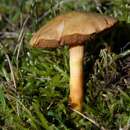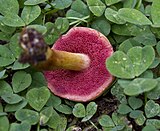fi
nimet breadcrumb-navigoinnissa


Hřib (Chalciporus), neboli měďovník, je rod hub z čeledi hřibovitých a řádu hřibotvarých.[1]
Společným znakem jsou drobné plodnice, dužnina neměnící barvu (na řezu nemodrá) a hladký třeň bez síťky.
 hřib malinový Chalciporus pseudorubinus béžovorezavý malinové žlutohnědý Evropa v ČR zatím nenalezen[1]
hřib malinový Chalciporus pseudorubinus béžovorezavý malinové žlutohnědý Evropa v ČR zatím nenalezen[1]  hřib peprný Chalciporus piperatus hnědorezavý hnědorezavé hnědorezavý Evropa
hřib peprný Chalciporus piperatus hnědorezavý hnědorezavé hnědorezavý Evropa  hřib rubínový Chalciporus rubinus béžovorezavý růžové růžový Evropa syn. Rubinoboletus rubinus
hřib rubínový Chalciporus rubinus béžovorezavý růžové růžový Evropa syn. Rubinoboletus rubinus  Chalciporus pseudorubinellus plavý růžové plavý USA
Chalciporus pseudorubinellus plavý růžové plavý USA Hřib (Chalciporus), neboli měďovník, je rod hub z čeledi hřibovitých a řádu hřibotvarých.
Společným znakem jsou drobné plodnice, dužnina neměnící barvu (na řezu nemodrá) a hladký třeň bez síťky.
Die Zwergröhrlinge (Chalciporus) sind eine Pilzgattung aus der Familie der Dickröhrlingsverwandten (Boletaceae). Sie umfassen in Europa je nach Gattungskonzept zwei bis drei Arten, von denen die Typusart, der Pfeffer-Röhrling (C. piperatus)[1][2], weit verbreitet und häufig anzutreffen ist.[3]
Die Zwergröhrlinge bilden meist sehr kleine, 7–10 cm hohe Fruchtkörper mit einem 2–6 cm breiten Hut. Die Poren bzw. Röhrenmündungen sind dunkelorange bis rosa-rötlich und rostrot gefärbt. Das gelbliche, gelblichweiße Fleisch hat einen rötlichen Schein und zeigt bei Kontakt mit Luftsauerstoff keine Farbreaktion. Es riecht und schmeckt nur bei C. piperatus pfefferartig scharf.
Die Zwergröhrlinge bevorzugen eher saure Böden (Nadel- oder Laubwälder auf Sandstein) und kommen oft an Wald- oder Weidenrändern einzeln oder gesellig vor.
Sie sind von Sommer bis Herbst anzutreffen.
Weltweit sind 25 Arten bekannt.[4] In Europa kommen 3 Spezies vor bzw. sind dort zu erwarten:[5][6]
Pfeffer-Röhrling
Chalciporus piperatus
Zwergröhrling
Chalciporus amarellus
Der Kurzsporige Röhrling (Rubinoboletus rubinus) wird teilweise auch zur Gattung Chalciporus gezählt.
Die Systematik der Zwergröhrlinge ist komplex und wurde in der Literatur vielfach unterschiedlich interpretiert. Es wurden einige Arten beschrieben, die teilweise wieder mit anderen synonymisiert wurden. Die hier beschriebene Artenliste folgt der Auffassung von Klofac & Greilhuber, die die Taxa Chalciporus pseudorubinus, C. xanthocystis und C. pierrhuguesii mit C. amarellus synonymisieren.[5]
Phylogenetische Untersuchungen zeigten, dass es sich bei dem Pfefferröhrling (C. piperatus) um eine Sammelart handelt. Mit C. pseudopiperatus wurde 2020 eine Art dieses Artkomplexes beschrieben, weitere haben noch keinen Namen.[6]
Zwergröhrlinge sind kaum zu verwechseln. Die rote bis rostrote Haut- und Stielfarbe, das gelbliche Fleisch und (beim Pfeffer-Röhrling) der scharfe Geschmack sind markante Merkmale. Untereinander kann die Abgrenzung schwieriger ausfallen. Einige Autoren sehen in Chalciporus amarellus – zu Unrecht – nur eine Varietät des Pfeffer-Röhrlings.
Die Zwergröhrlinge sind essbar. Der Pfeffer-Röhrling wird von vielen Sammlern fälschlicherweise als Gewürzpilz verwendet, die pfefferartige Schärfe verschwindet jedoch beim Garen.
Die Zwergröhrlinge (Chalciporus) sind eine Pilzgattung aus der Familie der Dickröhrlingsverwandten (Boletaceae). Sie umfassen in Europa je nach Gattungskonzept zwei bis drei Arten, von denen die Typusart, der Pfeffer-Röhrling (C. piperatus), weit verbreitet und häufig anzutreffen ist.
Chalciporus is a genus of fungi in the family Boletaceae (suborder Boletineae).[1] There are approximately 25 species in the genus.[2]
French mycologist Frédéric Bataille erected the genus in 1908, though it did not gain general acceptance for several decades and was often classified as a section (Piperati) of the genus Suillus or related to the genus Pulveroboletus. The type species is Chalciporus piperatus.[3] Rolf Singer resurrected the genus in 1973, separating the species from the genus Suillus on the basis of distinct pigments.[4] The name is derived from the Ancient Greek khalkos "copper",[5] and translates as "copper pores".[6]
The genus Chalciporus, together with the genus Buchwaldoboletus form a group of fungi that is an early offshoot in the Boletaceae. Many members of the group appear to be parasitic.[7] Wu and Yang proposed that this clade be called the subfamily Chalciporoideae.[8] The genus Rubinoboletus was merged into this genus based on their morphological similarity,[9] and subsequent genetic analysis—mainly due to Rubinoboletus (now Chalciporus) rubinus being nested within Chalciporus.[3][8]
Members of the genus Chalciporus have boletoid fruit bodies with pores that are various shades of red to pink, stipes lacking in reticulations, yellow mycelium and smooth oval spores.[3]
Two species, C. chontae and C. radiatus, have pores that are arranged in furrows that radiate out from the top of the stipe under the cap and resemble gills.[3]
C. piperatus and C. piperatoides are peppery-tasting, the former is edible while the latter is unknown. C. rubinellus and C. pseudorubinellus are milder-tasting and edible.[6]
Chalciporus is a genus of fungi in the family Boletaceae (suborder Boletineae). There are approximately 25 species in the genus.
French mycologist Frédéric Bataille erected the genus in 1908, though it did not gain general acceptance for several decades and was often classified as a section (Piperati) of the genus Suillus or related to the genus Pulveroboletus. The type species is Chalciporus piperatus. Rolf Singer resurrected the genus in 1973, separating the species from the genus Suillus on the basis of distinct pigments. The name is derived from the Ancient Greek khalkos "copper", and translates as "copper pores".
The genus Chalciporus, together with the genus Buchwaldoboletus form a group of fungi that is an early offshoot in the Boletaceae. Many members of the group appear to be parasitic. Wu and Yang proposed that this clade be called the subfamily Chalciporoideae. The genus Rubinoboletus was merged into this genus based on their morphological similarity, and subsequent genetic analysis—mainly due to Rubinoboletus (now Chalciporus) rubinus being nested within Chalciporus.
Members of the genus Chalciporus have boletoid fruit bodies with pores that are various shades of red to pink, stipes lacking in reticulations, yellow mycelium and smooth oval spores.
Two species, C. chontae and C. radiatus, have pores that are arranged in furrows that radiate out from the top of the stipe under the cap and resemble gills.
C. piperatus and C. piperatoides are peppery-tasting, the former is edible while the latter is unknown. C. rubinellus and C. pseudorubinellus are milder-tasting and edible.
Chalciporus es un género de hongos de la familia Boletaceae. Todos sus representantes son setas y comprenden alrededor de 25 especies. Se distribuyen en todos los continentes excepto en la Antártida y Oceanía. Algunos pocos son setas comestibles.[1]
Incluye las siguientes especies:[2]
Chalciporus es un género de hongos de la familia Boletaceae. Todos sus representantes son setas y comprenden alrededor de 25 especies. Se distribuyen en todos los continentes excepto en la Antártida y Oceanía. Algunos pocos son setas comestibles.
Chalciporus est un genre de champignons de la famille des Boletaceae, proche du groupe des Boletus edulis. Petites espèces bolétoïdes à chapeau sec, velouté et viscidule par temps humide. Les pores sont de couleur rouille à maturité. Pied parfois excentré et jaune à la base.
Chalciporus Bataille
Chapeau :
Cuticule sèche ou subviscidule, glabre.
Chair jaune pâle ou blanche, ou rarement rosé pâle, bleue chez certains spécimens.
Hyménium : adné à subdécurent, rouge mat, brun cannelle, carmin à rose saumon ou rarement bleu.
Stipe (pied) : sec, pruineux à glabre, avec mycélium basal jaune brillant.
Sporée : brune. Spores fusiformes courtes ou ellipsoïdes, lisses.
Régions Nord tempérées et pantropicales.
Mycorhizes avec les Pinaceae et les Fagaceae.
Certains Calchiporus forment un groupe, tandis que Calchiporus olivasporus est une espèce monogénique.[style à revoir]
Chalciporus est un genre de champignons de la famille des Boletaceae, proche du groupe des Boletus edulis. Petites espèces bolétoïdes à chapeau sec, velouté et viscidule par temps humide. Les pores sont de couleur rouille à maturité. Pied parfois excentré et jaune à la base.
Chalciporus Bataille, Bulletin de la Société d'Histoire Naturelle du Doubs 15: 39 (1908).
Il Chalciporus è un genere di funghi di taglia piccola appartenenti alla famiglia delle Boletaceae, provvisti di pori e tubuli di solito rosso cannella o rosastro, grandi e angolosi.
Sono caratterizzati dal sapore amaro o piccante della carne, che li rende non commestibili.
Il Chalciporus piperatus è però commestibile, ma talmente piccante da poter essere usato unicamente nel misto come condimento.
La specie tipo è il Chalciporus piperatus (Bull.) Bataille (1908).
Altre specie sono:
Chalciporus Bataille, Bulletin de la Société d'Histoire Naturelle du Doubs 15: 39 (1908).
Il Chalciporus è un genere di funghi di taglia piccola appartenenti alla famiglia delle Boletaceae, provvisti di pori e tubuli di solito rosso cannella o rosastro, grandi e angolosi.
Sono caratterizzati dal sapore amaro o piccante della carne, che li rende non commestibili.
Il Chalciporus piperatus è però commestibile, ma talmente piccante da poter essere usato unicamente nel misto come condimento.
Pipirbaravykis (lot. Chalciporus, vok. Pfefferröhrlinge) – baravykinių (Boletaceae) šeimos grybų gentis.
Lietuvoje auga viena rūšis – kartusis pipirbaravykis (Chalciporus piperatus).
Rubīnbekas (Chalciporus, pēc mikologu daļas uzskatiem - arī jaunveidotā Rubinoboletus) ir beku dzimtas sēņu ģints, kura sastāv no ap 25 sugām, bet Latvijā ir konstatētas divas no tām — rubīnbeku tipiskā suga piparu rubīnbeka un sarkanā jeb rubīna rubīnbeka, turklāt otro no tām Latvijā biežāk pieskaita samtbeku ģintij.[1] Ģints latīniskais nosaukums veidots no sengrieķu valodas un saistīts ar šai ģintij biežajām vara krāsas stobriņu atverēm.
Rubīnbekas veido mikorizu gan ar skuju, gan ar lapu kokiem, daudzas šīs ģints sēnes ir parazītiskas. Aug mežos, retāk parkos vai pie atsevišķiem kokiem. Augļķermeņi parasti parādās no jūlija līdz oktobrim, labvēlīgos klimatiskos apstākļos no jūnija līdz novembrim.
Index Fungorum[2] uzrāda 37 sugas vai varietātes, kas pieder vai kādreiz piederējušas pie rubīnbeku ģints, taču ne visas tās pašlaik tiek par tādām atzītas. No Mycobank uzrādītajām pašreiz pie ģints pieder ap 25 sugām:
Rubīnbekas (Chalciporus, pēc mikologu daļas uzskatiem - arī jaunveidotā Rubinoboletus) ir beku dzimtas sēņu ģints, kura sastāv no ap 25 sugām, bet Latvijā ir konstatētas divas no tām — rubīnbeku tipiskā suga piparu rubīnbeka un sarkanā jeb rubīna rubīnbeka, turklāt otro no tām Latvijā biežāk pieskaita samtbeku ģintij. Ģints latīniskais nosaukums veidots no sengrieķu valodas un saistīts ar šai ģintij biežajām vara krāsas stobriņu atverēm.
Chalciporus is een geslacht van schimmels behorend tot de familie Boletaceae.
Het geslacht Chalciporus bevat volgens de Index Fungorum onder andere de volgende soorten:
Chalciporus is een geslacht van schimmels behorend tot de familie Boletaceae.
Chalciporus Bataille (maślaczek) – rodzaj grzybów należący do rodziny borowikowatych (Boletaceae)[1].
Pozycja w klasyfikacji: Boletaceae, Boletales, Agaricomycetidae, Agaricomycetes, Agaricomycotina, Basidiomycota, Fungi (według Index Fungorum)[1].
Nazwę polską podali Barbara Gumińska i Władysław Wojewoda w 1983 r[2].
Niewielkich rozmiarów grzyby mikoryzowe, naziemne, występujące wyłącznie pod drzewami iglastymi. Wytwarzają owocniki z gładkimi i włóknistymi kapeluszami o przeważnie lepkiej powierzchni i rurkowatym hymenoforze, a rurki są łatwo oddzielające się od miąższu. Pory rurek mają kolor cynamonowy, karminowy, winnoczerwony lub różowy. Miąższ niezmienny[3][4].
Wykaz gatunków (nazwy naukowe) na podstawie Index Fungorum. Obejmuje on tylko gatunki zweryfikowane o potwierdzonym statusie. Oprócz tych wyżej wymienionych na liście Index Fungorum znajdują się gatunki niezweryfikowane[5]. Nazwy polskie według Władysława Wojewody[2].
Chalciporus Bataille (maślaczek) – rodzaj grzybów należący do rodziny borowikowatych (Boletaceae).
Chalciporus là một chi nấm thuộc họ Boletaceae (phân bộ Boletineae).[1][2]
Chalciporus là một chi nấm thuộc họ Boletaceae (phân bộ Boletineae).
Chalciporus Bataille, 1908
Типовой видХальци́порус (лат. Chalciporus) — род трубчатых грибов семейства Болетовые (Boletaceae) (или Strobilomycetaceae).
Хальци́порус (лат. Chalciporus) — род трубчатых грибов семейства Болетовые (Boletaceae) (или Strobilomycetaceae).